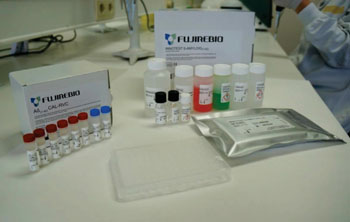APOE Genotype Biomarkers Evaluated for Alzheimer Disease
By LabMedica International staff writers
Posted on 18 Sep 2014
Cerebral spinal fluid (CSF) levels of β-amyloid 42(Aβ42) are associated with the diagnosis of Alzheimer disease (AD) and (Aβ) accumulation in the brain independent of apolipoprotein E (APOE) gene makeup. Posted on 18 Sep 2014
The APOE gene is the most prominent susceptibility gene for late-onset AD and for the best clinical use of genetic and CSF biomarkers, studies are needed to clarify to what extent the APOE genotype and CSF biomarkers are related and if they provide information for the diagnosis and prognosis of AD.

Image: Innogenetics sandwich enzyme-linked immunosorbent assays for Alzheimer disease biomarkers (Photo courtesy of Fujirebio).
Scientists at the Sahlgrenska University Hospital (Gothenburg, Sweden) with colleagues from other institutes, examined whether APOE genotype affects the diagnostic accuracy of CSF biomarkers for AD, in particular Aβ42 levels. They used data from three different cohorts: Cohort A included 1,345 people (ages 23 to 99 years) with baseline CSF levels, including 309 individuals with AD, 287 with prodromal (mild) AD, 399 with stable mild cognitive impairment, 99 with dementias other than AD and 251 controls. Cohort B included 105 younger individuals (ages 20 to 34 years) without dementia with CSF samples. Cohort C included 118 patients (ages 60 to 80 years) with mild cognitive impairment symptoms who underwent imaging and a CSF tap.
The team measured CSF levels of T-tau using a sandwich enzyme-linked immunosorbent assay (ELISA) Innotest hTau-Ag (Innogenetics; Ghent, Belgium), which detects all tau isoforms irrespective of phosphorylation status. They determined CSF levels of P-tau (at threonine 181) using another Innogenetics sandwich enzyme-linked immunosorbent assay, Innotest Phospho-Tau (181-P). The CSF concentration of Aβ42 was measured using a third Innogenetics sandwich ELISA Innotest β-amyloid (1-42), designed to detect the 1st and the 42nd amino acids in the Aβ protein.
The CSF level of Aβ42 but not total tau and another tau type were lower in APOE carriers with the ɛ4 alternative form of the gene compared with noncarriers regardless of the diagnostic group (cohort A). CSF levels of Aβ42 differed between patients with AD when compared with controls and those with stable mild cognitive impairment. CSF levels of Aβ42 and APOE ɛ4 genotype were predictors of AD diagnosis. In cohort B, APOE ɛ4 carrier status did not influence CSF levels of Aβ42. In cohort C, the APOE ɛ4 genotype did not influence CSF levels of Aβ42.
The authors concluded that the APOE ε4 allele is associated with lower CSF levels of Aβ42 but not T-tau or P-tau in age groups in whom amyloid pathology is prevalent and also in the absence of manifest AD that the clinical cutoff level for CSF Aβ42 should be the same for all APOE genotypes. CSF biomarkers are strongly associated with AD diagnosis and cortical Aβ deposition independently of APOE ε4 genotype. The study was published on August 27, 2014, in the journal JAMA Psychiatry.
Related Links:
Sahlgrenska University Hospital
Innogenetics














